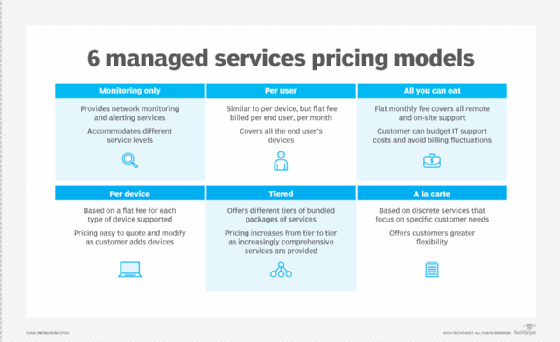6 popular managed services pricing models
Popular pricing models for managed service providers include monitoring only, per device, per user, all you can eat, a la carte and the tiered pricing model.
Popular managed services pricing models in use today offer a range of options for generating revenue.
For a startup managed service provider (MSP) or a company transitioning to managed services from another channel business model, pricing ranks among the top considerations along with sales and service delivery. How to price your services is a critical question and one that requires careful deliberation. A misstep here can damage a service provider's prospects for growth and profitability.
The primary managed services pricing models at an MSP's disposal include monitoring only, per device, per user, tiered pricing, all you can eat and a la carte. The following sections describe each pricing model and its core attributes. All have something to offer a budding MSP business, but there must be a close fit between the model and how your customers want to buy services.
1. Monitoring-only pricing model
Sold in small and medium-sized businesses (SMBs), as well as midsize and enterprise environments, the monitoring-only pricing model provides network monitoring services and alerting services by the MSP, the midsize or enterprise customer's in-house IT staff or both.
In this scenario, several different service levels can be employed. For example, an SMB-focused offering that provides operating system and software application patch management, antivirus and antispam updates, disk optimization and backup monitoring for a flat fee per month allows the MSP to bill for additional remediation activities identified through remote monitoring. A midsize or enterprise service-level offering forwards all alerts to the customer's in-house IT staff only and allows MSPs to address and perform all incident resolution. Another service level might be where the MSP participates in basic incident resolution or even more advanced support.

2. Per-device pricing model
The per-device pricing model is fairly simple and many MSPs use it primarily for this reason. The premise is to develop a flat fee for each type of device that is supported in a customer environment. For instance, a basic per-device pricing model might designate a flat fee of $69 per desktop, $299 per server, $29 per network printer and $99 per managed network.
The benefits of this approach, compared to other managed services pricing models, are that per-device pricing is very easy to quote and illustrate costs for a potential customer. It's also easy for the MSP to modify the monthly service fee as the customer adds additional devices.
Something to think about when evaluating this model is that it can lend itself to selling managed IT services based more on price rather than benefit. The experienced MSP will realize this and will modify their sales presentation accordingly.
3. Per-user managed services pricing model
The per-user pricing model is like the per-device pricing model, with the difference being that the flat fee is billed per user, per month and covers support for all devices used by each user. This might entail supporting an office PC, a mobile device -- or devices such as laptops or smartphones -- a home PC and connectivity and communication from hotels and kiosks while traveling.
4. Tiered pricing model
The tiered pricing model might be the most popular among MSPs. The premise is to build several bundled packages of services with each increasingly more expensive package providing more services to the customer.
With the tiered pricing model, for instance, a "bronze" desktop managed services package might include basic phone and remote support, patch management and virus and adware removal for an entry-level price. Bumping up to the higher priced "silver" desktop managed services package might include on-site visits, and the "gold" package might include emergency after-hours support -- being the highest-priced package.
5. All-you-can-eat pricing model
The all-you-can-eat pricing model is extremely flexible and includes all remote support, on-site support and lab or bench time for an entire organization for a flat fee per month. It also might provide 24/7 year-round support or services during certain hours and/or days of the month only with additional charges billed for services rendered outside of those times.
The primary goal is to provide the customer with the ability to realistically budget their IT support costs over a year's time and to experience no extraordinary billing fluctuations.
6. A la carte pricing model
The a la carte model contrasts with all-inclusive, or bundled, managed services pricing models. In a la carte pricing, an MSP sells discrete services that address specific customer needs. Those services could include disaster recovery, managed backup and patch management. A la carte pricing gives customers the ability to select and pay for just the services they need. They can also select multiple offerings to create a customized package of managed IT services.
Choosing a pricing model
When it comes to MSPs and pricing models, there's a lid for every pot. It's up to the individual service provider to understand what they are offering, identify their likely customer prospects and price accordingly.
A company that is just entering the managed services market might want to start with a very limited monitoring offering, so, in that case, the monitoring-only pricing model could prove the best fit. A service provider that caters to customers that provision multiple devices for each employee could consider the per-user pricing approach. An MSP that wants to lure new customers with a basic offering, while also building in upsell potential, could select the tiered-pricing model.
In addition, it's possible to mix and match the various managed services pricing models. A service provider, for example, could use the all-you-can-eat approach to price most of its services and use the a la carte method to offer a couple of add-on services.
Managed services expert Erick Simpson is founder and chief strategist at ErickSimpson.com, a strategic consultancy.







